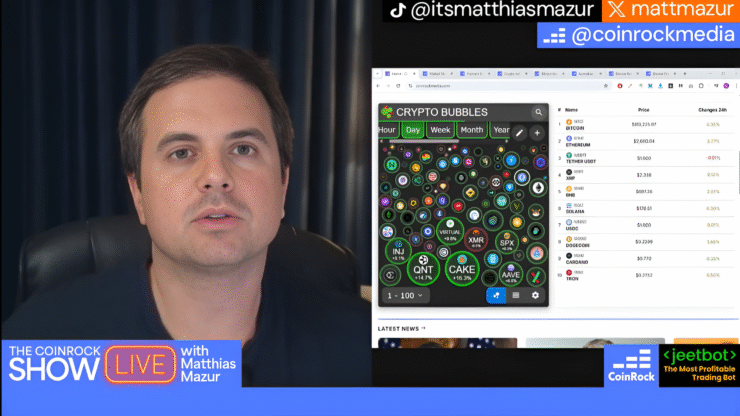In this week’s episode of The CoinRock Show, host Matthias Mazur opens with a market rally update that has everyone watching Bitcoin’s trajectory. With BTC reclaiming bullish momentum and altcoins perking up, excitement is building—but Matthias cautions that institutional behavior remains the real signal beneath the retail noise.
“What’s interesting about this year, I’d say the last 12 months is Bitcoin is at $110,000 and no one gives a shit. No one cares,” Matthias boldly said.
“Retail is not here. Your friends aren’t texting you to, you know, which is always a very good indication of the state of retail No interest there is no interest we haven’t seen euphoria and yet we see Bitcoin sitting at sitting at $110,000 so Again, that’s why $200,000 is the target

This set the perfect stage for the day’s guest: Laura K. Inamedinova, a venture investor, entrepreneur, and CGEO at Gate.io.
Laura brought a rare dual lens to the conversation—straddling global exchange leadership and venture capital oversight. As a Forbes 30 Under 30 honoree and Principal at Gate Ventures, her work sits at the intersection of big money and emerging innovation.
“I’ve been in space since I was 16… back in the days, I helped a lot of ICS being launched,” Laura explained.
“I came letters fresh out of college in those days. And then I was like, do I really want to build a career in like trade fi, you know, these no conventional industry because my background is in science. I have a Bachelor of Physics. Or should I go on this roller coaster ride into crypto? And I was like, crypto it is.”
With the introductions done,the episode went deep into the key behavioral differences between retail and VC investors, and what retail participants can learn from the long game of professional venture capital.
What Retail Gets Wrong—and VCs Get Right
The conversation kicked off with Laura offering a candid comparison between retail trading habits and the strategic mindset of VCs. Retail investors, she notes, often chase hype cycles, memes, or short-term technical signals without truly understanding the fundamentals. VC firms, by contrast, embrace time horizons that stretch over years, with a focus on thesis-driven bets.
“They [VC’S] are choosing not to invest in these crazy valuations and what they’re doing is liquids.” she explains.
“Now I would say 70% of VCs in my circle are doing liquid investments. They’re focusing on top 20 market cap projects going in”
She further explained from the VC point of view, why the trend has changed in recent times and what the Retail should look out for before seeking funding:
“Will you sustain that price or can you make sure it’s not going to again be the Burj Khalifa kind of graph for us?… Let’s say you raised let’s say 10 million, 20 million, that’s kind of the average raise, all this 10, 20 million is going to go into the market. Will you have enough buy pressure to sustain the price?”
She took it a step deeper:
“And the problem is, again, a lot of these projects, they’re faking their volumes. And we know that that’s a fact in the sensors. Thank God some of the market makers were charged for that because that’s market manipulation, that’s not allowed.”
“if you’re coming at this valuation, I don’t see how we as a VC is going to make money, especially if you’re putting into the perspective that we’re thinking we’re heading into recession.”
Matthias nodded to this, and affirmed how this kind of discipline is often missing from crypto’s noisy Twitter spaces or Discord calls, where speculation frequently outpaces reflection. He added:
“We see the same things, of course, right? Because it’s a very small space in venture capital. I think that the 2020 way of playing the VC game is over. The massive FDV’s are over.”
The VC Playbook: Patience, Patterns, and Power Law
One of the episode’s most insightful moments came when Laura broke down the VC mental model, especially around how outcomes are distributed. The majority of VC returns don’t come from small consistent wins—they come from outliers.
“VC investment thesis is high risk, high reward. Venture capital is all about getting that 5x, 10x, 100x. It’s not about making 20%. If I want to make 20%, there’s a lot of high yield bearing products where I can invest, play around.”
This mindset, she emphasizes, requires letting go of the need for instant gratification. VCs spend most of their time evaluating founders, understanding sectors, and mapping narratives over 5–10 year cycles. Retail investors, by contrast, often demand immediate returns and discard positions too early if they don’t moon in a few weeks.
She also points to the VC habit of using cycles to their advantage. During bear markets, professionals accumulate. During bull runs, they distribute.
“those who are maturing in the space, who understand how to interact would kind of try to buy back the audience. They’re the ones that are going to be super successful.”

How Laura Sees the Web3 Investment Landscape Evolving
As someone who straddles both the trading and venture worlds at Gate, Laura offered rare insight into how exchanges think beyond liquidity. On one hand, her role as CGEO involves forging international partnerships, expanding user bases, and optimizing platform utility. On the other hand, her position at Gate Ventures places her at the heart of crypto’s startup scene—where talent meets capital.
“I get around a hundred pitches per week.” she explained
“I look at the project, are the projects sustainable? What’s their business model? How are they going to be performing long-term? And is there an actual utility of the token? Or is the token just an easier way to fundraise because corporate VCs are stupid and they don’t understand anything?
Laura explained that this dynamic allows Gate to be more proactive in market development. Rather than waiting for projects to succeed, Gate Ventures often incubates them—helping fine-tune go-to-market plans, token designs, and strategic integrations. For her, this isn’t about controlling innovation. It’s about accelerating it the right way.
Looking ahead, Laura is bullish—not just on crypto markets, but on the structural evolution of the entire Web3 space.
“Ethereum, ETF are probably going to be staked soon. This is a great pathway for trade-Fi guys to come into crypto. So there’s going to be a huge inflow of capital, but this inflow of capital is going to be smart money. And they’re going to come for very much institutional kind of play.”
Importantly, Laura argues that Web3 is transitioning from ideology to utility—and the firms that survive will be those who internalize this shift. VCs are already positioning accordingly, doubling down on infrastructure, compliance-ready primitives, and user-centric products. She encourages retail participants to stop dwelling on the “spray and pray” Model, (Which she is not a big fan of,) and to focus on more ‘sustainable long-term offerings’.
Retail’s Mindset Reset
Laura spent the last part of the show sharing her personal experiences with Retails and founders she encounters every other day. She detailed her experiences and unraveled several powerful keynote steps that would benefit retailers who aim to get into the funding game with Gate. she also shared a side note, catchy insight for all aspiring investors:
“I hate LinkedIn in certain aspects, but in other aspects, it’s actually a goldmine if you know how to use it. So I’m very active there. I write a lot of content there because I feel like I need to educate the founders on how to pitch. I would say, if you’re a founder and you want to learn how to pitch for a business, read my LinkedIn.”
The episode didn’t just offer an insider’s look into VC behavior—it delivered a practical roadmap for retail investors looking to level up. Laura’s core message is clear: start thinking like a long-term allocator, not a hype-chaser. Patience, research, and pattern recognition aren’t optional—they’re survival skills in the world of asymmetric bets.
She ended with a strong advice for all aspiring founders:
“If you don’t have a previous crypto track record, don’t raise from VCs. And I’ll tell you what to do instead. Go get a job, get your track record, find co-founders. You need to have tier one project experience before doing your own thing. If you don’t have it, it’s going to be very hard.”




